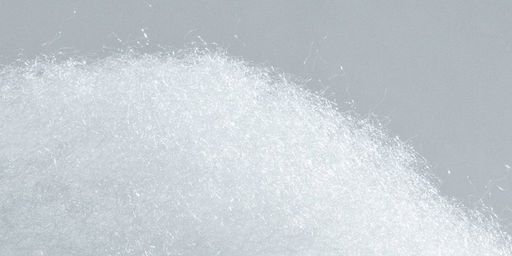Fluffs (and more)
Pet parents love to get their dogs, especially puppies, cute and cuddly stuffed toys. Some of the favorites are rabbits, squirrels and ducks - often what they like to chase in real life. It always begins innocently enough but at some point the mauling begins.. and with it come the fluffs!

Who hasn't had a living room filled with pieces of white stuffing that seem to expand forever? Yes, it is a bit of a chore to clean up and there is a certain amount of guilt about the destruction of the cute toy, but is that all pet parents have to worry about?
Unfortunately not. And while we most frequently associate fluffs with those little toys, fluffs and their relatives are scattered throughout most homes. First, a quick review,.
Background Material
So, what are fluffs anyways? The most common type - the kind that is fluffy like cotton candy and seems to expand as it is pulled - is called polyester fiber fill. Poly fiber fill is a synthetic fiber of a chemical polymer made from ethylene glycol and terephthalic acid. Translation: it's a plastic, made from oil and a bunch of other (not so nice) stuff in a complex process. While the production is highly regulated and involves exposure to various hazardous materials, the end result is considered very safe.
The more general name for the base material is PET which you may be familiar with as the common plastic soda bottle. In fact, there is also stuffing (batting) made from recycled PET containers. It tends not to be quite as fluffy as the the good stuff. Polly Flock is another similar product but with thicker strands so it feels denser.
What are some competitors to poly fiber fill? One that is gaining popularity is corn fiber fill as it is from a natural precursor, is relatively cheap and has near identical properties as a finished product. Wool and kapok, also naturally occurring, existed before the advent of polyester materials and are still used today, though less so. Cotton fiber fills are also popular. In case you go looking specifically for 'eco-friendly' fiber fills, remember that even the natural raw materials are heavily processed to end up looking and feeling like poly fiber fill.
In some cases, poly fiber fill will be treated, most often with a silicate. The silicon coating make the poly fibers more resistant to bacteria and the accumulation of dust, an attractive feature for use in stuffed toys and many other items. Other fiber fill materials may also be treated with an antimicrobial coating or biocide made from zeolites (crystalline aluminosilicates).
Unlike synthetic foams (also polymer based) such as those found in sleeping pads and some pillows, poly fiber fill is usually not treated to reduce flammability as it is already considered a relatively low flammability, say compared to cotton material or some foams. California recently changed their laws and no longer require manufacturers to treat materials considered a fire risk (like stuffing in a sofa) with flame retardants. As California regulations often affect the entire nation, there should be a gradual reduction in the use of treated materials in many other products. Many foams though are treated with biocides to prevent mildew and bacteria growth if they get wet.
What are the risks?
Pet Toys
So now that you have a better handle on the materials, what is the risk to Fido when he shreds that cute stuffed squirrel?
The initial risk is that of choking while trying to swallow some fluffs. Given how much fluffs expand when ripped up, only smaller pieces are at all likely to be swallowed but given how dry and stringy they are, once in the esophagus fluffs may get stuck and interfere with breathing, drinking or eating.
The secondary risk is that once swallowed, the material causes an intestinal blockage. Symptoms include vomiting, abdominal pain, lethargy, behavior changes, dehydration, constipation or diarrhea and a loss of appetite. Also keep in mind that a blockage may be partial and that digestion takes 12 to 24 hours.
In many decades of dog ownership, I have not had one swallow a significant amount, if any, of any type of toy filling. I have seen the next day evidence of tennis ball fuzz and even the odd small piece of fabric but not fiber fill. So my empirical observation says that most dogs are inclined not to swallow fiber fill, though they do enjoy pulling it out of toys and further pulling it apart to make as huge a mess as possible. However, just because my dogs were not so inclined does not mean yours won't think fiber fill is pizza.
Child Toys
Oh no... Junior's teddy has just been shredded and he is in tears. But your dog may soon be as well. The same risks as for pet toys apply to stuffed toys and "plushies" intended for kids (or adults!). Wood "wool" (shredded wood) is sometimes used in teddys and other toys may be filled with pellets made from silicon, plastic, glass or metal.
Unlike pet toys, there is a greater risk that fire retardants will have been applied to the batting - and those chemicals are pretty toxic, though probably not immediately life threatening. Humans with Pica Syndrome have been eating foams for a long time, sometimes from treated couch cushions, and have lived to talk about it. 1
Household Items for Humans
Look around your home and you will undoubtedly find many items with fiber fills or foams. Throw pillows. Chair and sofa cushions. Bed pillows. Sleeping and other comfort pads. Even some quilts. All are at risk of a puppy going on a binge or an adult dog with anxiety/separation issues. As the pet parent, it is your job to keep your baby away from things it does not know can injure. Likewise, a pet parent needs to take action to prevent an adult dog from making a bad situation worse. If you can't trust your dog alone when you are not present, keep them in a crate or kennel.
Treatment
If you have seen your dog swallow fiber fill or foam you may need to act very quickly. Clearly, if they are choking, do what you must to try to remove the obstruction but get in the car to the vet pronto if you fail. PetMD has some pointers on how to handle choking but remember that fiber fill is not likely to just pop out the way food or a harder object might.
If your dog is showing symptoms of an abdominal obstruction and/or you suspect they ate fiber fill or foam, contact your vet for an emergency visit. If the toy or other destroyed object is on hand, bring it in the car in case your vet needs to see it or contact the manufacturer for product information.
While minutes are not always urgent, hours are. Your vet may be able to use an endoscope to remove any pieces of fill or foam your dog has swallowed that are lodged in her throat or still in the stomach. Once the object moves into the intestines, only two paths remain - passing the obstruction naturally or surgery. So time is important - endoscopy is far better than surgery!
Wrap Up
Our safety recommendation is to avoid fiber filled toys unless you are certain your dog will not destroy them. While not as pleasing, there are many unstuffed toys available in stores that are a safer alternative, though hazards do remain from trying to swallow pieces of the fabric.
Pet parents also must be aware that the risks from fiber fill and foam go well beyond pet toys and encompass our entire homes. So, while you may "puppy proof" low cabinet doors, also keep stuffed or filled objects out of reach too. My personal belief is that foam is likely the larger risk to you dog, if only for the many non toy related avenues of unsupervised opportunity.
Finally, pet parents should only allow their dogs to play with toys that were intended for dogs. Toys designed for human children, stuffed animals in particular, may contain materials that can be more harmful for your pet if ingested than those used specifically in pet products.
1. I am aware of one case documented by a vet recounted on the internet of a dog that died from ingestion of fiber fill. As described, the issue seemed to be with the decomposition of the material inside the body and not just a blockage. The initial report suggested flame retardant chemicals were to blame but the treating vet believes it was a biocide coating that was the culprit (from her conversation with the manufacturer) I can't be certain that the true facts are all known as such incidents should be far higher if the common biocides, or even flame retardants, could cause so much damage so quickly.


